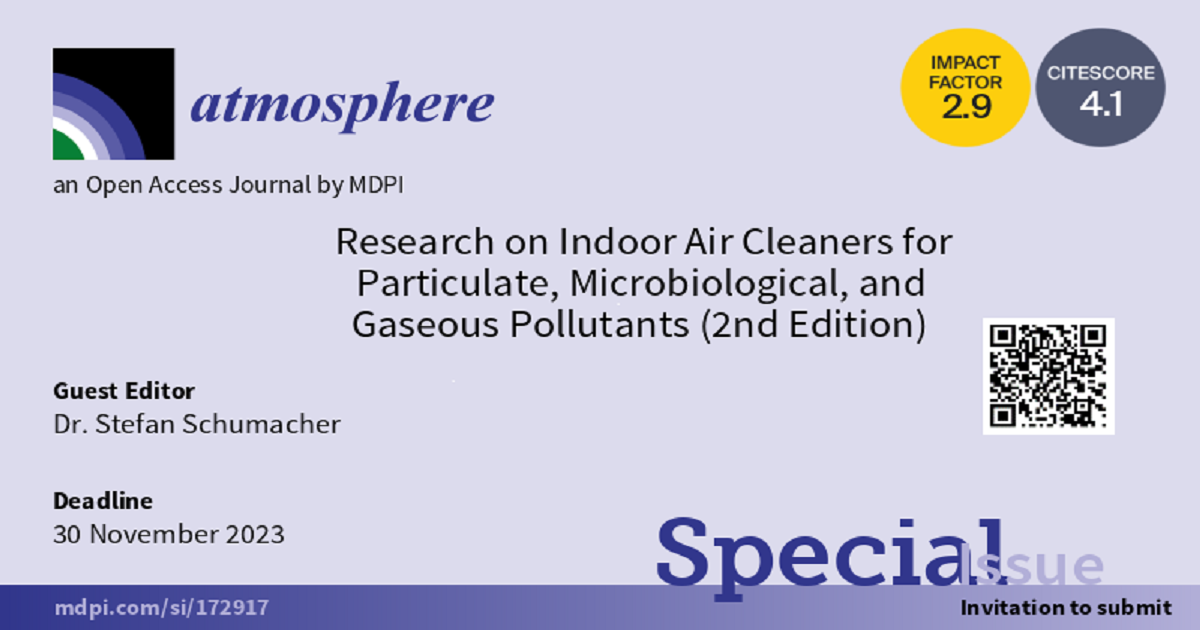Research on Indoor Air Cleaners for Particulate, Microbiological and Gaseous Pollutants
A special issue of Atmosphere (ISSN 2073-4433). This special issue belongs to the section "Air Pollution Control".
Deadline for manuscript submissions: closed (20 March 2023) | Viewed by 18589

Special Issue Editor
Interests: aerosols; filtration; air cleaners; indoor air
Special Issues, Collections and Topics in MDPI journals
Special Issue Information
Dear Colleagues,
In the course of the growing awareness for air pollution, air cleaners have been used for decades to improve indoor air quality. This especially includes air cleaners for particulate pollutants, based either on established technologies such as fibrous (HEPA) filters and electrostatic precipitators or alternative filtration concepts. The relevant particle size range extends from ultrafine particles which are omnipresent in indoor environments up to coarse particles such as pollen or dust at workplaces. Throughout the COVID-19 pandemic, the global interest in indoor air cleaners has substantially increased as they can also contribute to minimizing infection risks by filtration or inactivation (e.g., by UV-C) of viruses or virus-carrying droplets. In addition to air cleaners for particulate pollutants, there are also solutions for gaseous pollutants, e.g., based on activated carbon or photocatalysis.
Although there has already been a lot of research on air cleaners, there are still many open questions: How can air cleaners be further optimized in terms of cleaning efficacy, power consumption, and noise emissions? How can long-term stability be determined and increased? How is the distribution of the cleaned air in a room affected by its geometry, furnishing, and occupancy? Can potential health benefits be tested with bioaerosols or demonstrated in toxicological or epidemiological studies? Scientific answers to these and further questions will at least deliver input for the current standardization project for indoor air cleaners of the International Electrotechnical Commission (IEC).
Contributions from all applicable fields are welcome, whether they deal with technical aspects of the devices and filters, new measurement techniques or methods for assessing the efficacy, observations or simulations in real environments, or studies on the health effects of indoor air cleaners.
The 2nd Edition of the Special Issue has been online. Please refer to the following link: https://www.mdpi.com/journal/atmosphere/special_issues/J1S67P8RK4.
Dr. Stefan Schumacher
Guest Editor
Manuscript Submission Information
Manuscripts should be submitted online at www.mdpi.com by registering and logging in to this website. Once you are registered, click here to go to the submission form. Manuscripts can be submitted until the deadline. All submissions that pass pre-check are peer-reviewed. Accepted papers will be published continuously in the journal (as soon as accepted) and will be listed together on the special issue website. Research articles, review articles as well as short communications are invited. For planned papers, a title and short abstract (about 100 words) can be sent to the Editorial Office for announcement on this website.
Submitted manuscripts should not have been published previously, nor be under consideration for publication elsewhere (except conference proceedings papers). All manuscripts are thoroughly refereed through a single-blind peer-review process. A guide for authors and other relevant information for submission of manuscripts is available on the Instructions for Authors page. Atmosphere is an international peer-reviewed open access monthly journal published by MDPI.
Please visit the Instructions for Authors page before submitting a manuscript. The Article Processing Charge (APC) for publication in this open access journal is 2400 CHF (Swiss Francs). Submitted papers should be well formatted and use good English. Authors may use MDPI's English editing service prior to publication or during author revisions.
Keywords
- indoor air cleaners
- filtration
- ultra-fine particles
- bioaerosols
- gaseous pollutants
- COVID-19
- test methods
- simulations
- field experiments
- health effects
Benefits of Publishing in a Special Issue
- Ease of navigation: Grouping papers by topic helps scholars navigate broad scope journals more efficiently.
- Greater discoverability: Special Issues support the reach and impact of scientific research. Articles in Special Issues are more discoverable and cited more frequently.
- Expansion of research network: Special Issues facilitate connections among authors, fostering scientific collaborations.
- External promotion: Articles in Special Issues are often promoted through the journal's social media, increasing their visibility.
- e-Book format: Special Issues with more than 10 articles can be published as dedicated e-books, ensuring wide and rapid dissemination.
Further information on MDPI's Special Issue polices can be found here.





